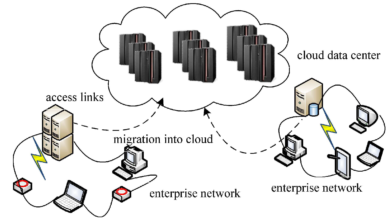Microservices on Data Servers
The world of data management is undergoing a paradigm shift with the emergence of microservices on data servers. As organizations grapple with the ever-increasing volume, variety, and velocity of data, traditional monolithic architectures are proving to be inadequate. Microservices, on the other hand, offer a more flexible and scalable approach to managing data, enabling organizations to unlock the true potential of their data assets.
In this comprehensive blog article, we will delve into the world of microservices on data servers, exploring their benefits, challenges, and best practices. Whether you are a data professional, an IT manager, or simply interested in the latest trends in data management, this article will provide you with a deep understanding of how microservices are revolutionizing the way we handle data.
Understanding Microservices: A Primer
In today’s fast-paced digital landscape, traditional monolithic architectures are struggling to keep up with the demands of modern data management. Enter microservices, a software architectural style that breaks down applications into smaller, independent services. These services are loosely coupled and can be developed, deployed, and scaled independently, allowing for greater agility and flexibility in data management.
Microservices differ from monolithic architectures in several key ways. Firstly, they promote a modular approach to application development, where each service focuses on a specific business capability. This modularity enables teams to work on different services simultaneously, speeding up development and deployment cycles. Additionally, microservices communicate with each other through lightweight protocols such as HTTP or messaging queues, allowing for seamless integration and interoperability.
The Advantages of Microservices
Microservices offer numerous advantages over traditional monolithic architectures when it comes to data management. One of the key benefits is scalability. With microservices, individual services can be scaled independently based on their specific resource requirements, allowing organizations to optimize resource allocation and handle spikes in data processing efficiently.
Another advantage of microservices is fault isolation. In a monolithic architecture, a failure in one component can bring down the entire system. Microservices, on the other hand, are isolated from one another, meaning that a failure in one service does not impact the overall system. This fault isolation enhances system resilience and ensures that data processing continues uninterrupted.
Deployment Flexibility
Microservices also offer deployment flexibility, allowing organizations to adopt a hybrid or multi-cloud approach to data management. With microservices, services can be deployed independently on different servers or cloud platforms, enabling organizations to leverage the benefits of various infrastructure providers and avoid vendor lock-in.
Furthermore, microservices facilitate rapid development and deployment cycles. Since services are decoupled, teams can work on different services simultaneously, accelerating time-to-market. This agility is particularly beneficial in data-driven industries where fast decision-making based on real-time insights is crucial.
The Role of Data Servers in Microservices
Data servers play a pivotal role in enabling microservices architecture. In a microservices environment, each service requires access to data for processing and decision-making. However, managing data in a distributed, decoupled architecture presents unique challenges.
Data Partitioning
Data partitioning is a critical consideration when it comes to microservices on data servers. Since services are independent and scalable, data needs to be partitioned and distributed across multiple servers or databases to ensure efficient data access and processing. This partitioning can be based on various criteria such as customer ID, geographical location, or time period, depending on the specific requirements of the application.
By partitioning data, organizations can achieve better performance and scalability. Each service can operate on its subset of data, reducing contention and improving data access times. Additionally, data partitioning allows for parallel processing, enabling faster and more efficient data analytics and insights.
Data Consistency
Ensuring data consistency in a microservices architecture is challenging due to the distributed nature of the services. In a monolithic architecture, data consistency is typically maintained within a single database. However, in a microservices environment, data may be spread across multiple databases or data stores.
To address this challenge, organizations can employ various strategies such as eventual consistency or distributed transactions. Eventual consistency allows for some degree of inconsistency between services but ensures that data eventually becomes consistent over time. Distributed transactions, on the other hand, ensure immediate consistency but come with additional complexity and performance overhead.
Data Access Patterns
Data access patterns play a crucial role in the performance and efficiency of microservices on data servers. Depending on the specific use case, organizations can adopt different data access patterns such as command-query responsibility segregation (CQRS) or event sourcing.
CQRS separates read and write operations, allowing for optimized data retrieval and processing. By segregating read and write operations, organizations can scale each independently based on their specific requirements. Event sourcing, on the other hand, captures and stores all changes to an application’s data as a sequence of events. This approach enables organizations to rebuild the current state of the data at any point in time, providing a complete audit trail and facilitating data-driven decision-making.
Benefits of Microservices on Data Servers
Microservices on data servers offer a plethora of benefits for organizations seeking to optimize their data management processes. Let’s explore some of these benefits in detail.
Improved Scalability
One of the primary advantages of microservices on data servers is improved scalability. With traditional monolithic architectures, scaling the entire system can be challenging and resource-intensive. Microservices, on the other hand, allow organizations to scale individual services independently based on their resource requirements.
For example, in a retail application, the inventory management service may experience a surge in traffic during peak shopping seasons. By scaling this service independently, organizations can ensure optimal performance and avoid bottlenecks. This scalability enables organizations to handle fluctuating data loads efficiently and maintain a high level of service availability.
Enhanced Flexibility and Agility
Microservices on data servers provide organizations with enhanced flexibility and agility in data management. With microservices, services can be developed, deployed, and updated independently, allowing for faster innovation cycles and reduced time-to-market.
For instance, suppose a financial institution wants to introduce a new feature in its mobile banking application. With microservices, the development team responsible for the specific service can work on it independently, without affecting other parts of the application. This decoupling of services allows organizations to respond quickly to changing business requirements and customer demands.
Fault Isolation and Resilience
In a monolithic architecture, a failure in one component can bring down the entire system, leading to data unavailability and potential financial losses. Microservices on data servers, however, offer fault isolation, ensuring that a failure in one service does not impact the overall system.
For example, in an e-commerce application, if the payment service experiences an issue, customers can still browse products and add them to their carts. This fault isolation enhances system resilience and prevents a complete system outage, allowing organizations to maintain continuous data processing and minimize disruptions.
Improved Performance
Microservices on data servers can significantly improve performance by enabling parallel processing and optimized data access. Since services are independent and can be scaled individually, organizations can distribute data processing across multiple services, reducing contention and improving overall performance.
For instance, in a healthcare application, if multiple services need to access patient data simultaneously, the data can be partitioned and distributed across different servers. This parallel processing of data allows for faster data retrieval and analysis, facilitating timely decision-making and improving the overall user experience.
Flexibility in Technology Stack
Microservices on data servers offer organizations the freedom to choose the most suitable technology stack for each individual service. In a monolithic architecture, organizations are often restricted to a single technology stack, limiting their ability to leverage the latest advancements in data management technologies.
With microservices, each service can be built using the most appropriate technology for its specific requirements. For example, a service responsible for real-time data analytics may use a stream processing framework like Apache Kafka, while a service handling transactional data may utilize a relational database management system like PostgreSQL.
Challenges and Considerations
While microservices on data servers offer numerous advantages, they also come with their own set of challenges and considerations. Let’s explore some of these challenges and discuss best practices for mitigating them.
Data Synchronization
One of the primary challenges in a microservices environment is ensuring data synchronization between services. Since services are decoupled and operate independently, maintaining data consistency can be complex, especially in scenarios where multiple services need to access and update the same data.
Organizations can address this challenge by employing event-driven architectures and asynchronous communication. By using message queues or event streaming platforms, services can communicate and react to data changes in real-time, ensuring that data remains synchronized across services.
Service Discovery and Load Balancing
In a microservices architecture, services need to discover and communicate with one another dynamically. This presents challenges in terms of service discovery and load balancing.
Organizations can leverage service discovery tools and frameworks like Consul or Eureka to automateservice discovery and load balancing. These tools allow services to register themselves and discover other services dynamically, ensuring seamless communication between services. Load balancing techniques such as round-robin or weighted round-robin can be employed to distribute incoming requests evenly across multiple instances of a service, optimizing resource utilization and improving overall system performance.
Security Concerns
Microservices on data servers introduce new security challenges compared to monolithic architectures. With multiple services interacting with sensitive data, organizations need to ensure robust security measures are in place to protect data integrity and prevent unauthorized access.
Implementing authentication and authorization mechanisms such as OAuth2 or JSON Web Tokens (JWT) can help secure service-to-service communication. Additionally, encryption techniques like Transport Layer Security (TLS) can be employed to secure data transmission between services. Regular security audits and vulnerability assessments should also be conducted to identify and address potential security risks.
Monitoring and Observability
Monitoring and observability are crucial in a microservices environment to ensure the health, performance, and availability of services. With multiple services operating independently, organizations need to have visibility into each service’s performance metrics, logs, and error rates.
Implementing centralized logging and monitoring solutions like Elasticsearch, Kibana, and Prometheus can help organizations gain insights into the overall system performance and detect potential issues. Additionally, integrating distributed tracing frameworks like Jaeger or Zipkin can provide end-to-end visibility into service interactions, enabling efficient troubleshooting and performance optimization.
Testing and Continuous Integration/Continuous Deployment (CI/CD)
Ngadsen test2
Testing and CI/CD processes are crucial in a microservices architecture to ensure the stability and reliability of the overall system. With multiple services operating independently, organizations need to adopt robust testing strategies and efficient CI/CD pipelines.
Implementing automated testing frameworks like JUnit or Selenium can help organizations streamline the testing process and ensure consistent quality across services. Adopting CI/CD practices, such as using tools like Jenkins or GitLab CI/CD, enables organizations to automate the build, test, and deployment processes, ensuring rapid and reliable releases of new features or bug fixes.
Best Practices for Microservices on Data Servers
While addressing the challenges discussed above, organizations can follow some best practices to ensure the successful implementation and operation of microservices on data servers:
Service Decomposition
Careful service decomposition is essential to achieve the benefits of microservices architecture. Services should be designed to be autonomous and focused on specific business capabilities, adhering to the single responsibility principle. This decomposition enables independent development, deployment, and scaling of services, ensuring loose coupling and high cohesion.
API Design
Well-defined and well-documented APIs are critical for seamless communication between services. Organizations should follow RESTful principles or adopt API specifications like OpenAPI (formerly known as Swagger) to ensure consistency and ease of integration. Implementing versioning strategies and providing backward compatibility can also facilitate smooth service evolution and minimize disruptions.
Containerization and Orchestration
Containerization technologies like Docker provide a lightweight and portable way to package services and their dependencies. Organizations can leverage container orchestration platforms like Kubernetes or Docker Swarm to manage and scale containers efficiently. Containerization and orchestration enable organizations to achieve scalability, fault tolerance, and efficient resource utilization in a microservices environment.
Monitoring and Observability
As mentioned earlier, monitoring and observability are crucial for maintaining the health and performance of microservices on data servers. Organizations should implement centralized logging, metrics, and tracing solutions to gain insights into the behavior and performance of services. Proactive monitoring can help detect issues early on, optimize system performance, and ensure a high level of service availability.
Documentation and Collaboration
Comprehensive documentation is vital in a microservices architecture to facilitate collaboration and knowledge sharing. Each service should have clear documentation, including its purpose, API contracts, data models, and deployment instructions. Establishing effective communication channels and fostering collaboration between teams responsible for different services can further enhance the success of microservices on data servers.
Real-World Use Cases
Microservices on data servers have been successfully implemented across various industries and organizations. Let’s explore a few real-world use cases to understand how microservices are revolutionizing data management.
E-commerce Giants
E-commerce companies like Amazon and Alibaba handle massive amounts of data, from product catalog management to order processing and fulfillment. By adopting microservices on data servers, these companies achieve scalability, fault tolerance, and flexibility in managing their vast data infrastructure. Microservices allow them to handle high traffic volumes during peak shopping seasons, ensuring a seamless and responsive user experience.
Financial Institutions
Financial institutions, such as banks and insurance companies, rely on data-intensive applications to process transactions, manage customer accounts, and analyze financial risks. Microservices on data servers enable these organizations to handle high volumes of financial data efficiently. With microservices, they can build real-time fraud detection systems, analyze market trends, and provide personalized recommendations to customers, enhancing their competitive advantage in the industry.
Healthcare Providers
In the healthcare industry, managing patient data securely and efficiently is crucial. Microservices on data servers enable healthcare providers to build scalable and interoperable systems that facilitate seamless data exchange between different healthcare stakeholders. By adopting microservices, healthcare providers can improve patient care coordination, enable real-time analytics for disease surveillance, and enhance medical research and development processes.
Future Trends and Innovations
The world of microservices on data servers is evolving rapidly, with new trends and innovations shaping the future of data management. Let’s explore some of the emerging technologies and their potential impact:
Serverless Computing
Serverless computing, also known as Function-as-a-Service (FaaS), allows organizations to build and run applications without managing the underlying infrastructure. With serverless architectures, organizations can focus on writing and deploying individual functions, further enhancing the modular nature of microservices. Serverless computing enables organizations to scale services automatically, reduce operational costs, and increase development agility.
Edge Computing
Edge computing brings data processing and computation closer to the data source, reducing latency and enabling real-time analytics. In a microservices architecture, edge computing can be leveraged to process data at the network edge, enabling faster insights and reducing reliance on centralized data servers. Edge computing can be particularly beneficial in scenarios where real-time decision-making is critical, such as autonomous vehicles, industrial IoT, or remote monitoring applications.
Artificial Intelligence and Machine Learning
Integrating artificial intelligence (AI) and machine learning (ML) capabilities into microservices on data servers can unlock new possibilities in data management. AI and ML algorithms can be embedded within microservices to enable real-time data analysis, predictive modeling, and intelligent decision-making. Organizations can leverage AI and ML to automate data processing, detect patterns and anomalies, and personalize user experiences.
Tools and Technologies
Various tools and technologies have emerged to support microservices on data servers. Let’s explore some of the popular ones:
Containerization and Orchestration
Containerization platforms like Docker and container orchestration frameworks like Kubernetes or Docker Swarm provide the foundation for deploying and managing microservices. These tools enable efficient resource utilization, scalability, and fault tolerance in a distributed environment.
API Gateways
API gateways act as a central entry point for all incoming requests to microservices. They provide functionalities such as request routing, load balancing, authentication, and rate limiting. Popular API gateway tools include Kong, Tyk, and Ambassador.
Service Mesh
Service mesh technologies like Istio or Linkerd provide a dedicated infrastructure layer for managing service-to-service communication in a microservices architecture. They handle functionalities such as service discovery, load balancing, traffic management, and distributed tracing, simplifying the complexity of microservices interactions.
Data Streaming Platforms
Data streaming platforms like Apache Kafka or Apache Pulsar enable reliable, scalable, and real-time data ingestion and processing. They allow organizations to build event-driven architectures, capture and process streams of data, and enable communication between microservices through asynchronous messaging.
Conclusion
In conclusion, microservices on data servers are transforming the way organizations manage and leverage their data assets. By adopting a modular and scalable approach, organizations can achieve improved scalability, fault tolerance, and deployment flexibility. However, implementing microservices on data servers also brings challenges such as data synchronization, security concerns, and monitoring complexities. By following best practices and leveraging the right tools and technologies, organizations can successfully navigate these challenges and harness the transformative power of microservices on data servers.
The world of data management is evolving rapidly, and staying updated with the latest trends and innovations in microservices is crucial for organizations seeking to unlock the full potential of their data assets. Embracing microservices on data servers can empower organizations to efficiently handle the ever-increasing volume, variety, and velocity of data, driving innovation, and gaining a competitive edge intheir respective industries. As technology continues to advance, future trends such as serverless computing, edge computing, and the integration of AI and ML capabilities will further enhance the capabilities of microservices on data servers.
To successfully implement microservices on data servers, organizations must consider factors such as service decomposition, API design, containerization, and orchestration. Properly decomposing services based on business capabilities ensures loose coupling and high cohesion, enabling independent development and deployment. Well-designed APIs facilitate seamless communication between services, promoting interoperability and ease of integration.
Containerization technologies like Docker provide a lightweight and portable way to package services and their dependencies, while container orchestration platforms such as Kubernetes or Docker Swarm manage and scale containers efficiently. These technologies enable organizations to achieve scalability, fault tolerance, and efficient resource utilization in a microservices environment.
Monitoring and observability play a crucial role in maintaining the health and performance of microservices on data servers. Implementing centralized logging, metrics, and tracing solutions provides valuable insights into the behavior and performance of services. Proactive monitoring helps detect issues early on, optimize system performance, and ensure a high level of service availability.
Real-world use cases demonstrate the effectiveness of microservices on data servers across various industries. E-commerce giants leverage microservices to handle high traffic volumes during peak shopping seasons, ensuring a seamless and responsive user experience. Financial institutions utilize microservices to process transactions, manage accounts, and analyze financial risks, enabling real-time fraud detection and personalized recommendations. Healthcare providers benefit from microservices by improving patient care coordination, enabling real-time analytics, and enhancing medical research and development processes.
Looking towards the future, emerging technologies such as serverless computing, edge computing, and AI/ML integration will shape the evolution of microservices on data servers. Serverless computing allows organizations to focus on writing and deploying individual functions, reducing operational costs and increasing development agility. Edge computing brings data processing closer to the source, enabling real-time analytics and reducing latency. AI and ML capabilities embedded within microservices enable real-time data analysis, predictive modeling, and intelligent decision-making.
Various tools and technologies support microservices on data servers. Containerization platforms like Docker and container orchestration frameworks like Kubernetes simplify deployment and management. API gateways, service meshes, and data streaming platforms provide essential functionalities for service-to-service communication, traffic management, and asynchronous messaging.
In conclusion, microservices on data servers offer significant advantages in data management, including improved scalability, flexibility, fault tolerance, and performance. However, organizations must address challenges such as data synchronization, security concerns, and monitoring complexities. By following best practices, leveraging the right tools and technologies, and staying updated with the latest trends, organizations can successfully harness the transformative power of microservices on data servers to unlock the full potential of their data assets. Embracing this paradigm shift in data management will empower organizations to drive innovation, make data-driven decisions, and thrive in the rapidly evolving digital landscape.



